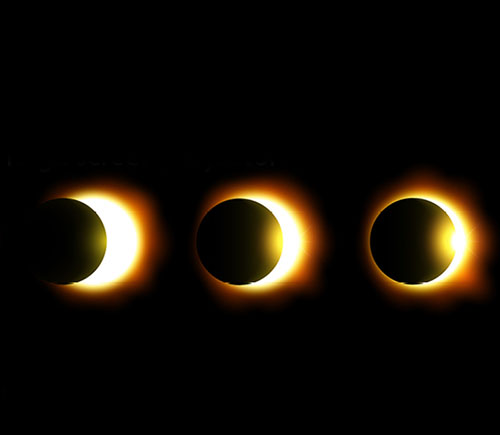 A team of students and faculty from Marshall University representing the West Virginia Space Grant Consortium will launch a high-altitude balloon on Monday, Aug. 21, as part of a nationwide, NASA-sponsored project to live-stream aerial video footage of the “Great American Eclipse.”
A team of students and faculty from Marshall University representing the West Virginia Space Grant Consortium will launch a high-altitude balloon on Monday, Aug. 21, as part of a nationwide, NASA-sponsored project to live-stream aerial video footage of the “Great American Eclipse.”
The team will launch the roughly 8-foot-tall, helium-filled balloon, which will carry a video camera and other equipment to an altitude of up to 100,000 feet, at approximately 12:20 p.m. CDT (1:20 p.m. EDT) from a remote site in southern Illinois. Live footage from the camera will be available for public viewing on NASA’s website, http:// eclipse.stream.live.
Dr. Jon Saken, associate professor of physics at Marshall, said the location near Cobden, Illinois, was chosen because it is on the route of the total eclipse. There were other reasons, as well, he said.
“I grew up in Cobden and my parents still live in the same house,” Saken said. “As luck has it, their house is right on the centerline. So not only do we have a free place to stay, I also have an extensive support network for everything from last minute repairs and construction to help with recovery. Perhaps most importantly, I still know all the back roads. Everywhere along the eclipse path, thousands of people will be gathering. The roads may become parking lots. If we have to get to the balloon quickly, the back roads may be our only hope.”
As part of the Eclipse Ballooning Project, 55 teams from across the country will live-stream footage of the total solar eclipse, in which the moon will entirely block the sun for approximately two minutes on a path progressing from the Pacific coast in Oregon (1:17 p.m. PDT) to the Atlantic coast in South Carolina (2:47 p.m. EDT).
The NASA-sponsored project, which is led by the Montana Space Grant Consortium (MSGC) at Montana State University, has been years in the making. According to MSGC Director Angela Des Jardins, the project marks the first time that high-altitude video footage of a total solar eclipse has been broadcast live.
“We’re excited to provide a unique perspective of this rare phenomenon,” Des Jardins said. “The live-stream video will show the curvature of the planet, the blackness of space, and the whole of the moon’s shadow crossing the Earth during the eclipse.”
In addition to a video camera, the team’s balloon will carry a GPS tracking system, a camera to capture still images of the eclipse, a prototype of an automatic astronomical target acquisition system, and a guest payload from the NASA IV&V Center in Fairmont, West Virginia. Once the eclipse has passed, the balloon will pop and the payloads will parachute to Earth.
The Montana Space Grant Consortium at Montana State University initiated the project in 2014. The project is sponsored by the NASA Science Mission Directorate and NASA’s Space Grant program, a national network that includes over 900 affiliates from universities, colleges, industry, museums, science centers, and state and local agencies belonging to one of 52 consortia in all 50 states, the District of Columbia and the Commonwealth of Puerto Rico.
Following its successful experiences with the Rocksat program, also funded through the West Virginia Space Grant Consortium, the Marshall Chapter of MUSpace was chosen by the consortium to participate in this project.
Student members of the team are Jacob Staggs and Derek Staley, who are computer science majors, and Nick Zarilla, a Spring 2017 math and physics graduate. They have been working with Saken.
“This has been a great experience to work with a resourceful team and network of teams on a project of this scale,” Staley said. “The life and work experiences gained from this project have been invaluable, and I will recall these throughout my future endeavors.”
He and Staggs said the obstacles they have faced in preparation have helped build their skills.
“The project has broadened the scope of possibilities for success in this field and given me new knowledge in the amount of mysteries our universe may hold,” Staggs said. “The opportunity to work on a project as ambitious as this project is a once-in-a-lifetime thing. Not only do I get to be a part of the first total solar eclipse that goes coast to coast since 1918, I also get the opportunity to gain experience working with a great team at Marshall and the great teams throughout the rest of the country that are participating. I am thankful for this opportunity and will carry all the knowledge I have gained from this project into my life.”
This project gave Zarilla an invaluable opportunity – the chance to apply what he’s learned to a real-world scientific project, he said. The guidance he received and skills he acquired “have helped me grow not only academically, but personally,” Zarilla said.
Saken expressed thanks to West Virginia Space Grant Consortium for choosing the Marshall group to be West Virginia’s team on this project. “We are also excited about the opportunity this provides to initiate a scientific ballooning program at Marshall, and hope to extend this to other schools across the state as well as expanding our K-12 outreach programs,” Saken said. “This kind of hands-on research is crucial to exciting students’ interest in science and technology.”
For more information about the national project and press materials, visit http://eclipse.montana.edu.